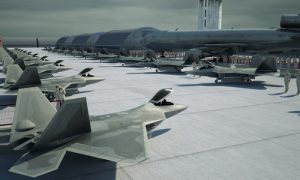
Funding cuts, a series of continuing resolutions and successive troop deployments have damaged the U.S. military, and will require more money than expected to repair it, U.S. Rep. Mac Thornberry (R-TX) said during a committee hearing on Wednesday.
Thornberry, the chairman of the House Armed Services Committee, convened the hearing to explore needed steps to rebuild the military ahead of the April 28 expiration of the current continuing resolution (CR), which funds the federal government.
The House approved a defense appropriations bill for fiscal year 2017 in March, but the Senate has yet to act on it. Continuing resolutions do not permit changes to funding and would not support an increase in defense funding.
“We need to get back to evaluating our defense needs on their own without regard to any agreement or disagreement we may have on other issues. The men and women who serve deserve at least that,” Thornberry said in his opening remarks.
Thornberry urged passage of a full defense appropriations bill for this year and then enacting adequate authorization and appropriations for fiscal year 2018.
“I understand that we must all be cautious about exposing our vulnerabilities,” he said. “But in order to do better for the military and for the country, we must have the best professional military judgment of our witnesses today on the current state of our military forces and on what a CR or inadequate funding would mean. To get on a better track we all have to be clear and candid with the American people.”
U.S. Rep. Martha McSally (R-AZ) raised questions during the hearing about the impact a CR would have on flying operations and Air Force readiness.
“That impact of another year long CR on our Air Force would be unprecedented,” McSally, a former A-10 pilot and squadron commander, said. “Pilots need to be ready to go anywhere in the world on twenty four hours notice. The cumulative effect of missing training throughout the year does have a degradation effect. We are a thousand fighter pilots short and we are grounding pilots then expecting them to stay. That’s insane.”
Air Force Chief of Staff Gen. David Goldfein confirmed McSally’s concerns, stating that squadrons would be grounded in June. There would be the equivalent of a “no-fly zone” over bases unless a unit on base was preparing to go into conflict, he said.
U.S. Rep. Mike Turner (R-OH), the chairman of the House Armed Services Subcommittee on Tactical Air and Land Forces, said that as a result of actions taken in the National Defense Authorization Act (NDAA) for fiscal year 2017, the Army is now reversing the downward trend in end-strength.
“We need to continue to look at ways to reasonably continue to grow the Army to minimize the risks associated with current and future operational demands,” Turner said.
Turner questioned Army Chief of Staff Gen. Mark Milley on the impact a potential year-long CR would have on military readiness.
Milley testified that a year-long CR would stop Army end-strength increases, and the Army would “essentially have to resume the downward trend in Army end-strength.”
In his prepared testimony, Milley also highlighted the potential damage of a continuing resolution. “This is no time, in my professional view, to increase risk to our national security. A year-long CR, or a return to the (Budget Control Act) BCA funding will do just that. It will increase risk to the nation, and it will ultimately result in dead Americans on a future battlefield.”



